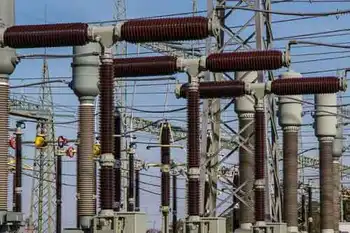New EVs offered at German auto show
By Associated Press
NFPA 70e Training - Arc Flash
Our customized live online or in‑person group training can be delivered to your staff at your location.

- Live Online
- 6 hours Instructor-led
- Group Training Available
GM's Cadillac brand won't have a presence in the sprawling Frankfurt Messe exhibition center when the show opened to the news media, and Chrysler's Dodge and Jeep have moved to the Fiat SpA stand.
And GM's European brands, Opel and Saab, will only serve to remind that GM is selling them. Other notable absences include Mitsubishi, Honda and Nissan's Infiniti, which are instead focusing on the upcoming Tokyo Motor Show.
Industry observers and the public will focus on advances in electric cars and hybrids, and for improvements that might bring the vehicles into the mainstream. They'll also look for clues about forthcoming small-car offerings from U.S. carmakers aiming to improve their line of fuel-efficient vehicles.
Top new product offerings include four new electrics from Renault, with one headed for consumers by 2011, including one with no internal combustion engine at all; a hybrid Mercedes B-Class, called the F-Cell, which sports a fuel cell and an electric motor; and the first plug-in version of Toyota's Prius hybrid, meaning its batteries can be charged from a household outlet.
GM will tout its Chevrolet Volt, a plug-in electric which uses an internal-combustion engine to extend its range beyond the standard commuting distances its batteries are designed to handle.
Those cars are headed for consumers soon, but BMW AG gives a look farther down the road with its low-slung supercoupe, the Vision EfficientDynamics. It's a high performance, plug-in diesel-electric hybrid powered by a three-cylinder 1.5-liter turbo engine, and by not one but two electric motors, one for the rear wheels, one for the front.
The BMW coupe is a concept car, designed to show designs and technology that might or might not be reflected in production models in coming years.
Those looking for an idea of U.S. automakers small-car offers can look at Ford's C-Max, aimed at replacing the Focus with a U.S. debut sometime in 2010, while Opel has a new version of its Astra, its mainstay in European markets.
The Astra will also give a preview of GM's plans for small cars in the United States. While GM has announced plans to sell 55 percent of its European subsidiary to parts supplier Magna International, it will keep a minority stake so it can keep on developing small and medium sized cars with Opel. The Astra uses an architecture Opel developed for GM to use in small cars worldwide, including the Volt.
"There will be an electric car at almost every stand," at this year's Frankfurt show, Ferdinand Dudenhoeffer, an industry expert at the University of Duisburg-Essen said, although it would be some time before they are on the production line and in dealer show rooms.
"Like in hybrids, the Japanese are ahead of the Germans in electric cars," he said. "One of the reasons is the battery technology which in Japan is systematically further developed.
"Another reason is Germans' strength in diesel," Dudenhoeffer said. "Large parts companies like Robert Bosch, for example, are behind the curve in batteries and electric cars," compared to the Japanese, he said.
He said Toyota has already built its 2 millionth hybrid car this year — an important link in the electric car chain — while Daimler's Mercedes S400, the only German hybrid on the market so far, has built less than 200 of the cars to date.
In August, Nissan Motor Co. in Japan unveiled the Leaf, an electric car scheduled to go into mass production for a global market in 2012. And U.S. President Barack Obama committed $2.4 billion in federal grants to develop next-generation electric vehicles and batteries in the U.S.
Last month, Germany's government said it would spend some (euros) 500 million over the next three years on a plan to put 1 million electric cars on the road by 2020, including (euros) 170 million on battery research.
The heavy batteries that take the place of international combustion engines and gasoline are expensive to produce, and countries like South Korea and Japan are far ahead in research and development. Improving them is key.
Analysts expect global production of purely electric cars to expand rapidly in the coming years. IHS Global Insight forecast that it will grow from nearly 9,500 this year to more than 58,000 in 2011.
Germany's Volkswagen AG, Europe's biggest automaker, has said it hopes to introduce its first electric cars on the market in 2013. It's expected to show off an electric version of its "Up!" city car. Daimler AG, which has been testing an electric version of its two-seater Smart, is working with California-based electric car maker Tesla Motors Inc. on developing better battery and electric drive systems.
Ford Motor Co. will also offer an all-electric commercial van in 2010 and plans to have three other electric vehicles available in the U.S. by 2012.
Elsewhere, rival Mitsubishi Motors Corp. launched an electric vehicle in June, the 4.59 million yen (US$48,300) i-MiEV, and other companies have plans in the works.
The industry remains in flux with sales still down because of the global economic crisis and the landscape has change since the last show in 2007. General Motors Co. sought and emerged from bankruptcy protection, has agreed to sell its Opel unit to Canada's Magna International Inc. and Sberbank. Chrysler Group LLC and Fiat SpA are now partners and Volkswagen AG dodged a takeover bid by Porsche SE, then turned the tables by initiating a takeover of Porsche.
Organizers said 753 exhibitors are on hand for the event, which will be opened to the public by Chancellor Angela Merkel Sept. 17 and run through Sept. 27.
Matthias Wissman, president of the German Association of Automotive Industry, said that 62 vehicle makers are at the show, with 82 world premieres.











